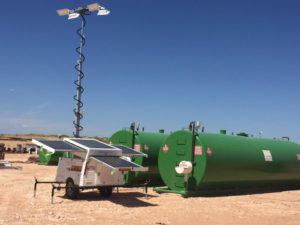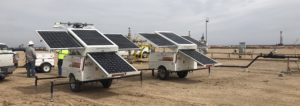Historically, the word “environmental” in the oil patch has had the connotation of inconvenience, hassle, and extra cost. Today, several things are converging to change that narrative—ESG has made it more necessary and technology has made it more user-friendly.
A case in point for the user-friendly side is the category of portable solar power for drill pad lighting, and for long term powering of onsite electronics.
Tulsa-based Site Solar was founded in 2016 to enter that niche, said the company’s Chief Operations Officer, Randy Heckenkemper.
 Site Solar’s trailer-mounted solar generators and solar-powered light systems combine panels with storage batteries to replace the diesel-powered variety at well sites across the South and Southwest, including the Permian, SCOOP/STACK and other oil basins.
Site Solar’s trailer-mounted solar generators and solar-powered light systems combine panels with storage batteries to replace the diesel-powered variety at well sites across the South and Southwest, including the Permian, SCOOP/STACK and other oil basins.
“Everybody’s concerned about the environment right now,” he said, “and [given] the fact that we save money on fuel and labor—we consider ourselves low-hanging fruit, helping ESG.”
Once onsite, the solar power generators are completely self-operating, because of the high number of sunny days in the Permian and elsewhere in their 18-southern-state “solar belt.” Heckenkemper reckons that, in 2020, replacing diesel generators with solar power will keep 25,500 metric tons of CO2 out of the atmosphere. The EPA’s greenhouse gas equivalencies calculator shows that to be equivalent to 2.5M gallons of diesel consumed.
That includes not only the diesel not used for generation itself, but that burned by delivery trucks bringing the fuel onsite. Heckenkemper says solar power also boosts reliability while cutting down on highway traffic. “One operator pointed out to us, instead of running trucks every other day to fuel these generators—they have generators that would run out of diesel fuel because of traffic jams on some of the highways—they don’t have to worry about that. We even reduce truck traffic on crowded highways.”
He also notes solar’s advantages at night, including cost savings and safety. For sites that have little nighttime activity, it can be costly to run diesel generators all night just in case someone needs the light. Solar powered lights can be triggered by a motion detector or a timer, using battery power to run only when needed.
“The safety is that the lights automatically come on and off, they’re quiet—there’s no noise, there’s no smell, they don’t have to worry about containment, they don’t have to worry about fines in case of [fuel] spills,” he said.
The job cycle for Site Solar often begins with light trailers arriving when the drill pad is surveyed and the earth movers fire up. “Our lights stay on through drilling and completion. And if they’re running automation on a flowing well, often times we bring in our solar generators and power the wellhead automation as the last thing on the job,” Heckenkemper noted.
Solar power is often one part of the power mix onsite, he added. “We don’t run pump jacks. That requires so much power. We run the automation, the chemical pumps, the gas loop, the low-power-draw items. That’s where our sweet spot is.”
Panels the company now uses are about 22-23 percent efficient—almost 10 times better than the three percent rate available in the early 1990s. The constant upgrading of panel and storage technology have led Site Solar to rent instead of sell their generators “because, as technology changes, we want to be able to upgrade our product,” Heckenkemper explained.
_____________________________________________________________________________________________________
Paul Wiseman is a freelance writer in the oil and gas sector.










